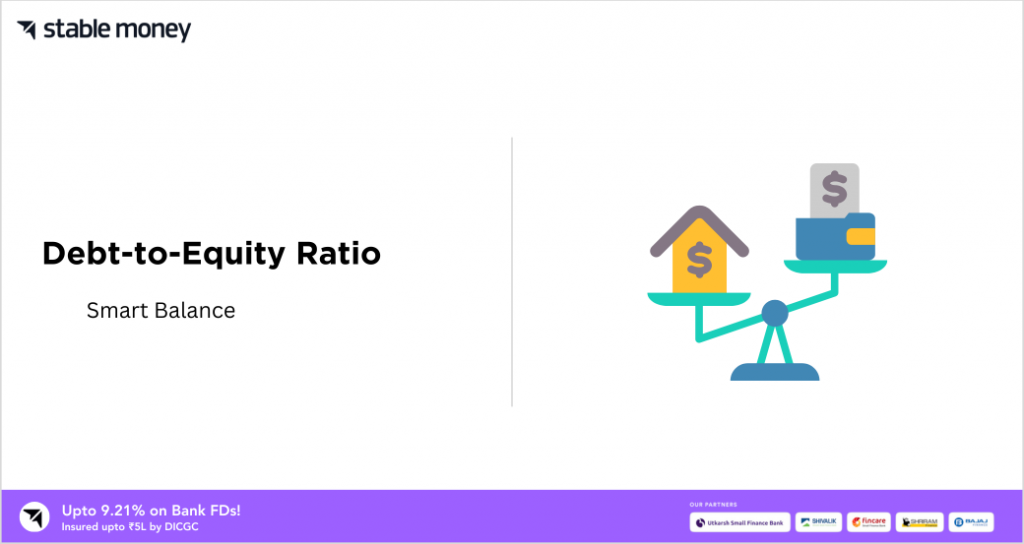
The primary consideration when evaluating the well-being of a specific company is its financial stature. Want to know how one can gauge it? It is the help of the debt to equity ratio that reveals whether a business is funding operations through debt or internal resources. Read on to find out more about this gauging meter:
What is the Meaning of Debt to Equity Ratio?
Debt to equity ratio is a crucial indicator within the realm of corporate finance and is used for evaluating a company’s financial leverage. The debt-to-equity ratio is calculated by dividing the total liability of the company by its shareholder equity. It gauges the extent to which a company funds its operations through debt rather than its capital.
Debt to Equity Ratio Formula
The D/E Ratios defines a company’s total debt to its total equity. Here is how you can calculate debt to equity ratio:
Debt/equity = Total debt/ total shareholder’s equity
Example:
Let us take an example wherein we have to find the debt-to-equity ratio of a company ABC. Now let us assume that the total liability of company ABC as per their financial statements is 50 crores and the total shareholder equity is 25 crores.
Now, apply the debt to equity ratio equation, i.e.,
Calculation of D/E Ratio
Total debt/ total shareholders equity= 50 crore/25 crore = 2
This implies that for every rupee of equity, company ABC has INR 2 as debt.
Different Types of Debt
The debt equity ratio definition can be stated as a crucial financial metric that offers a glimpse into the composition of a company’s capital makeup and financial leveraging. Understanding the various types of debts within this debt to equity framework stands useful in analyzing the financial health of a company. Here are the most common types of debt:
1. Long Term Liabilities
Also known as long-term debts, it is the debt payable to third-party creditors that extend beyond a 12-month time span. This sets them apart from current liabilities that a company has to settle down within the horizon of 12 months. The long-term liabilities are listed on the balance sheet alongside current liabilities.
2. Short-Term Liabilities
Also known as current liabilities, these financial obligations are such that they should be settled within a period of one year. Short-term debts usually include accounts payable, income taxes payable, lease payments, wages, and any other short-term bank loans.
3. Accrued Liabilities
Accrued liabilities denote an outstanding expense, indicating a cost that has been accrued over time but not yet settled. These liabilities usually include pending payments for goods and services that the company has already received but not yet paid for. Liabilities for various obligations can be accrued by a company and are subsequently reflected on its balance sheet.
4. Accounts Payable
As you can make out of the name, these are short term debts that a company owes to its product suppliers. Accounts payable can also refer to a specific department in a company dedicated to coordinating payments to suppliers.
What is the Characteristics of Ideal, Good & Bad Debt to Equity Ratio?
The Debt ratio and equity ratio are key financial metrics used to evaluate a company’s financial structure and risk. Here, let us differentiate between the three different types of D/E ratios:
1. Ideal D/E Ratios
On applying the debt to equity equation, if the resultant comes as 2:1, then it is considered an ideal debt to equity ratio. This implies that at all times, the debt should never be more than twice the company’s equity because this increases the risks of paying back the debts and may even result in bankruptcy in the worst cases.
2. Good D/E Ratios
As mentioned above, on applying the debt to equity formula, if the resultant varies between 1 and 1.5, then it can be termed a good debt to equity ratio. However, the debt equity ratio ideal may differ from company to company because certain sectors rely more heavily on debt financing than others.
3. Bad D/E Ratios
Applying the debt equity formula, if the resultant is more than 2, it is considered a bad debt to equity ratio. Any company that holds a D/E ratio between 2 and 7 is assumed to be at high risk. If a company fails to meet its debt payments and interests for multiple reasons, such as a drop in sales, meeting exigencies, etc., its D/E ratio rises. These companies usually stand out to be risky for investors. Besides their shares being low priced, there is always a fear of bankruptcy.
What is the Interpretation of D/E Ratios
The D/E Ratios stands helpful in determining the funding strategy of a company. This ratio aids in assessing whether the company has opted for equity or debt financing in support of its operations.
1. High D/E Ratios
A high debt-to-equity (DE) ratio signals an elevated level of risk. This implies that the company is incurring additional debt to fund its operational requirements. This indicates that in the case of a deficit in the finances of the nation, it relies on debt as a source of financing.
2. Lower D/E Ratios
A low ratio of debt to equity suggests that the company holds more shareholder equity than debt, which further implies that the company can manage its operations without obtaining any further loans to cover operational expenses. Having a higher capital than the borrowed amount impacts positively.
Is a Higher or Lower D/E Ratios Which One is Better?
Going by the debt equity definition and analyzing the same, a lower debt to equity ratio is considered to be better because it indicates that there are fewer debts on the balance sheet of a company compared to its equity shareholders. With that said, the situation may also fluctuate based on the company’s growth stage and industry sector. For example, new companies usually use debts to fuel their growth. It’s essential to assess D/E ratios in relation to industry peers or the same company across various periods.
Tips to Lower Your D/E Ratios
If your company’s D/E ratio is higher than industry norms, it could be beneficial to lower the same to enhance your company’s financial well-being and appeal. Here are a few tips that you can apply to lower your debt to equity ratio:
- Pay any loans that exist so as to balance your debt to equity ratio. Also, refrain from taking on additional loans to avoid a potential elevation in the debt-to-equity ratio.
- Focus on increasing sales and cutting expenses to implement cost-saving measures.
- Enhance inventory management and maintain optimal utilization of funds by efficiently handling the company’s inventory, preventing further finance wastage.
- If you’re dealing with high-interest credit, explore other options that can help in refinancing your current debt stature. Consider restructuring as an option to decrease your debt-to-equity ratio when market rates are at a low point.
How can D/E Ratio be Used to Measure a company’s Financial Risk & Profitability stage?
Debt to equity ratio is an indicator of the amount a company has taken in relation to the net value of its assets after deducting liabilities. Repayment or refinancing is mandatory for debt, and it carries interest expenses that are generally non-deferrable, and may jeopardize or destroy the equity’s value in case of default. Hence a higher debt to equity ratio associates with high investments risks and indicates that the particular company mostly relies on debt financing.
On the other hand, growth financed through debt may lead to enhanced earnings. Shareholders should expect a benefit if the additional profit surpasses the associated increase in debt service expenses. Yet, if the incremental cost of debt financing is greater than the additional income it generates, the share price might experience a decline. As a result, what seemed like a wise borrowing decision initially may prove unprofitable under varying conditions.
Benefits & Drawbacks of D/E Ratios
Though there are several advantages to debt financing, there are a few disadvantages, too, as it poses potential risks. Here, we list down the benefits and disadvantages of debt to equity ratios:
Benefits
1.Lower financial Risk
A lower DE ratio implies that the company faces decreased financial risk, making it less susceptible to default on its debt obligations. Thus, a lower debt to equity ratio provides an assurance that your investments are less likely to turn out risky.
2. Potential For Higher Returns
A higher DE ratio may signal that the company holds the capacity for enhanced returns as it utilizes debt to support its operational and investment activities. This results in a boost in the profits and the company’s leverage.
3. Flexibility in Financial Decision Making
A company maintaining a balanced or optimal debt to equity ratio is better positioned for flexible financial decision-making, thanks to its access to both debt and equity financing. This empowers the company to explore growth prospects and engage in strategic investments.
4. Tax Advantages For Business
The interest payments made on debt are tax-deductible, presenting a tax advantage to companies utilizing debt as a financing method. This could lead to a decrease in the company’s tax obligations, thereby augmenting its after-tax earnings.
Drawbacks
1. Higher Financial Risks
A higher D/E Ratios ratio implies that a company is at financial risk and may be facing difficulties in catering to its debt obligation, especially if the company is experiencing a decline in its profits and revenues. This could also increase the risks of bankruptcy.
2. Limited Financial Flexibility
An increased D/E Ratios could impede a company’s financial flexibility due to potential constraints imposed by debt covenants or restricted access to equity financing. Such limitations may further hinder the company from pursuing strategic investments or adjusting to fluctuations in the stock market.
Interest payments can pose a financial strain: Paying back the interest payments accrued on debt can be burdensome if the interest rate on the revenue of the company faces a decline. The outcome could be a reduction in the company’s profitability, constraining its ability to plow back funds for reinvestment in the business.
Final Word
We hope that this guide gives you an in-depth insight of debt equity ratio meaning and reasons why every company should hold a manageable D/E ratio. Undoubtedly, a marginally high debt to equity ratio brings forth some benefits, but companies that indulge in borrowing huge debts may struggle to pay back and even end up in bankruptcy. Investors with a long-term perspective can view a high DE ratio as an opportunity, but newbies and entrants should conduct comprehensive research before making investment decisions.
FAQs
A company that holds a debt to equity ratio of 1.5 means that the company has a debt of INR 1.5 for every INR 1 of equity in business. This D/E ratio shows how much debt a company has to pay compared to the investor equity.
Usually the finance and banking sector have a high debt to equity ratio. This is because banks have considerable fixed assets, particularly in the form of branch networks. Other debt-intensive sectors, such as airlines and industrials, may also possess a debt to equity ratio towards the higher side.
If a company has a high D/E ratio, the losses incurred by the company will be compounded, and it may face challenges in paying off the debts. Also, there can be an increase in the borrowing prices, which may also bring down the share prices of the company.
The debt to equity ratio of a company decreases when the shareholders receive dividends. While dividends are distinct from equity, issuing cash to shareholders depletes their equity derived from the company’s earnings.
The debt to equity ratio throws light on a company’s financial health and reflects the debt level a company owes. Neglecting this issue might lead the company into bankruptcy. Thus, it is imperative for investors to find out the D/E of the company they are planning to invest in because companies with a higher D/E ratio are more prone to losing money and going bankrupt. This ratio helps investors in making wise investment decisions.
decisions.
Disclaimer
This article is solely for educational purposes. Stable Money doesn't take any responsibility for the information or claims made in the blog.

